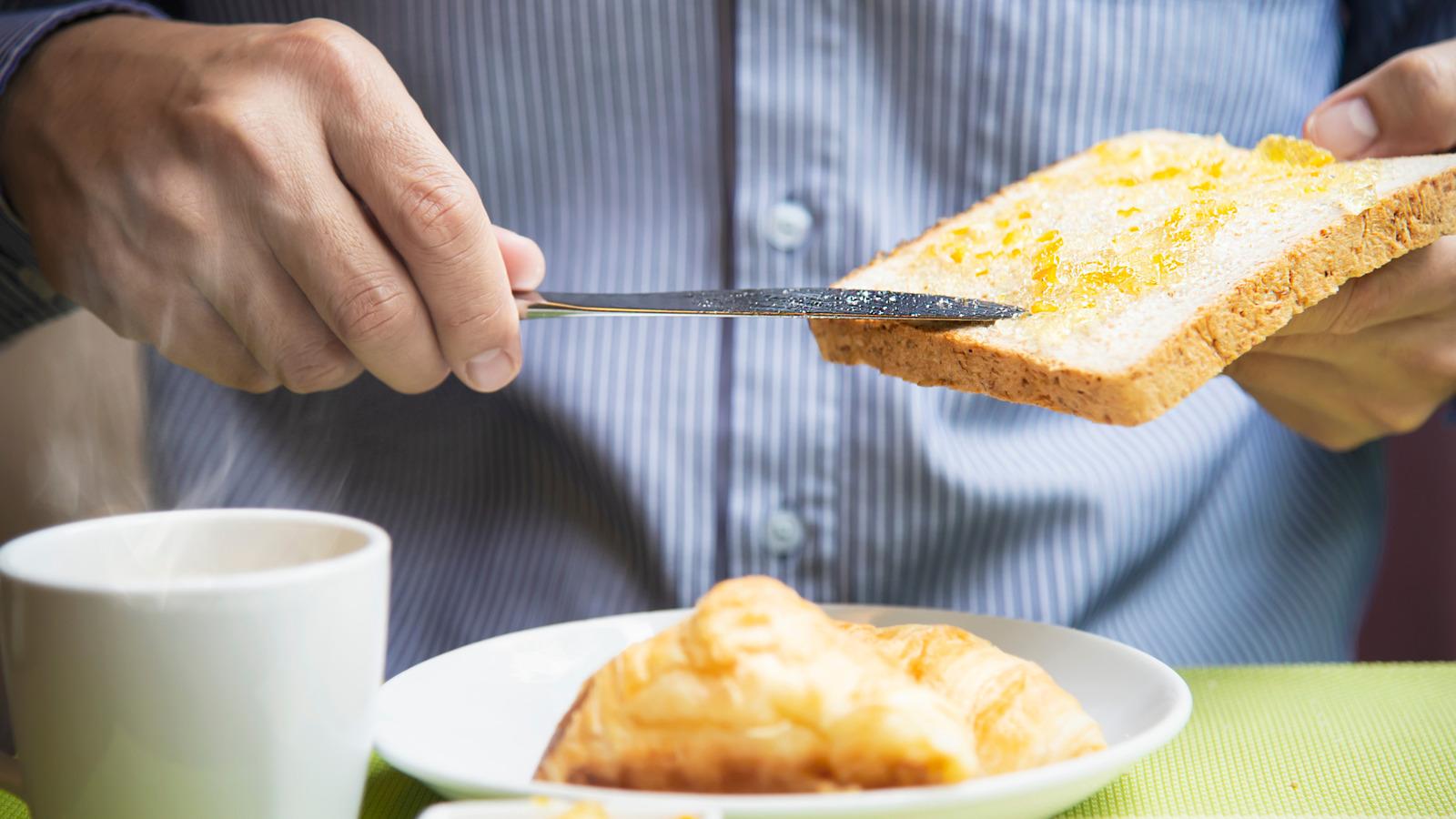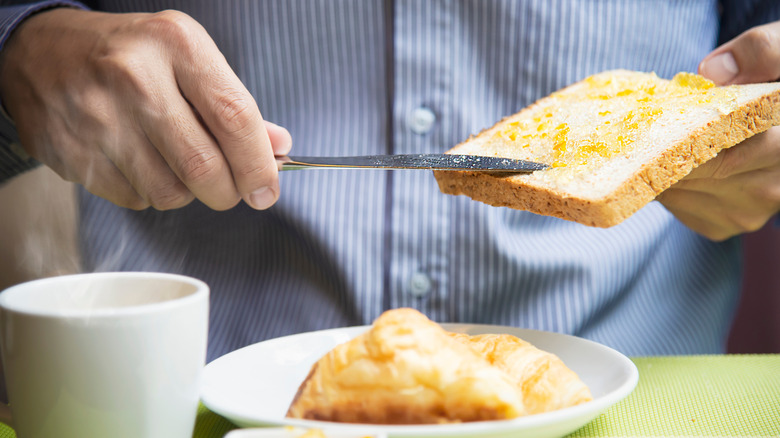
Pair Srinrat/Shutterstock
Breakfast may not make history books in the same way as wars and political upheaval, but that doesn't mean it's not interesting. For U.S. presidents, who live highly scheduled lives under constant scrutiny, breakfast can be a chance to take a minute for themselves.
Whether eating alone, with family, or with guests, it's interesting to see how U.S. presidents have tackled the most important meal of the day through the ages. Some kept it simple. Others leaned into regional foods or the habits of their upbringing. These morning meals reflect not just individual tastes but different eras, routines, and sometimes surprising quirks.
You might already know about some of the U.S. presidents' favorite foods, but what about their go-to morning meals?We're going to explore the favorite breakfasts of 14 presidents, from George Washington to Barack Obama. The aim isn't to analyze political legacies but to get a sense of the people behind the presidency through what they opted to eat after waking up. In some cases, these foods were regular habits; in others, they were favorites noted by cooks or staff. Either way, they help us see past the portraits and into the day-to-day lives of world leaders.
George Washington: Hoecakes
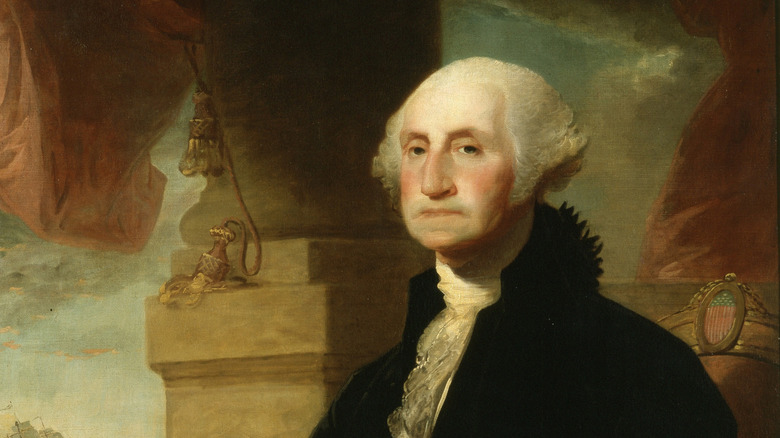
Smith Collection/gado/Getty Images
The early history of the United States isn't an easy one to stomach. George Washington was born into Virginia plantation life, and his breakfast choices reflect both colonial traditions and the availability of local ingredients. One of the first president's favorite morning meals was hoecakes, a kind of cornmeal flatbread.
It's commonly said that the name comes from the cooking method used by slaves, who prepared them on the flat side of a field hoe over an open flame. However, this seems unlikely, and the name more probably stems from another term for griddle. That said, slavery was still widespread at this time, and Washington himself owned 123 slaves – some of whom were responsible for preparing the family's meals — at the time of his death.
Hoecakes were simple, made from white cornmeal, yeast, and water. Washington enjoyed his hoecakes with plenty of melted butter and a generous drizzle of honey. The combination makes sense. Cornmeal was a staple crop, and honey would have been readily available at Mount Vernon, where Washington kept bees. This morning meal was often accompanied by tea rather than coffee, reflecting British influences that persisted during his lifetime.
Thomas Jefferson: Fresh bread and cold meats
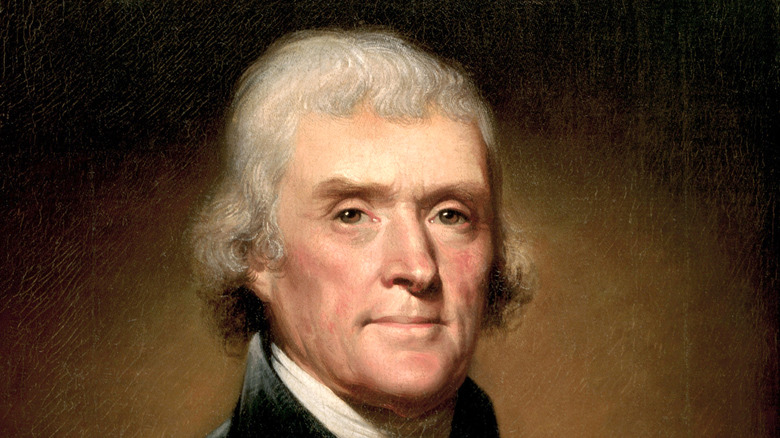
Graphicaartis/Getty Images
Thomas Jefferson's approach to breakfast was distinctly European, most likely shaped by his years as a U.S. minister in France. He didn't go in for elaborate hot breakfasts. Instead, he preferred a lighter, more continental-style meal, such as fresh bread and cold meats with coffee.
While it may seem sparse by today's American standards, this style of breakfast was common among the upper class in late 18th-century Europe, and Jefferson brought that influence home. What's more, the bread — which ranged from cornbread to hot wheat loaves — was said to always be fresh, and isn't that a treat, even today? Though Jefferson is remembered for his interest in fine dining and popularizing macaroni pasta in the U.S., his breakfasts were simple yet plentiful. They're also surprisingly timeless, with Jefferson's breakfast still popular today in many parts of the world.
Abraham Lincoln: Egg, toast, and coffee
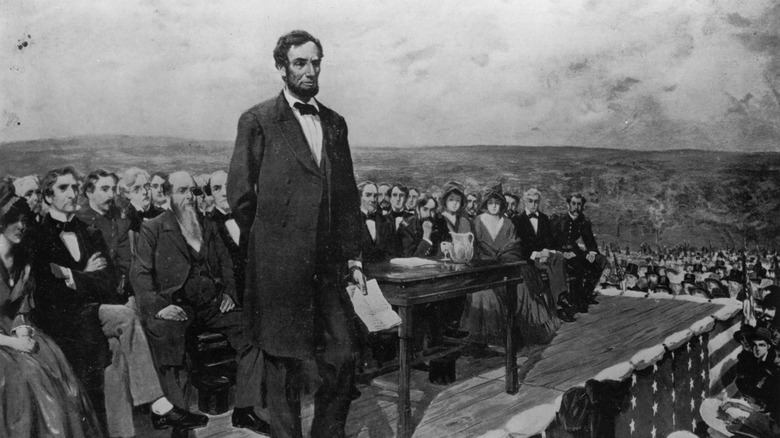
Library Of Congress/Getty Images
Abraham Lincoln was known for being fairly indifferent about food. He went for simple dishes rather than elaborate meals. Breakfast was no exception. His regular morning meal consisted of a single egg, toast, and a cup of coffee. It's a sparse plate, especially by 19th-century standards, but one that aligns with Lincoln's reputation for simplicity.
The choice of egg and toast is not surprising. Eggs were easily available, and toast required minimal preparation. Coffee was also already entrenched in American routines by this time. Lincoln may well have eaten more elaborate breakfasts with guests, but this seems to have been his simple, everyday go-to — at least when he remembered to eat breakfast. Mary Lincoln is said to have sometimes invited guests to breakfast, just so Lincoln would remember to come. Skipping meals does seem like a natural side-effect of being a wartime president, especially one who didn't care much about food.
Ulysses S. Grant: Flannel cakes, fried apples, and mackerel
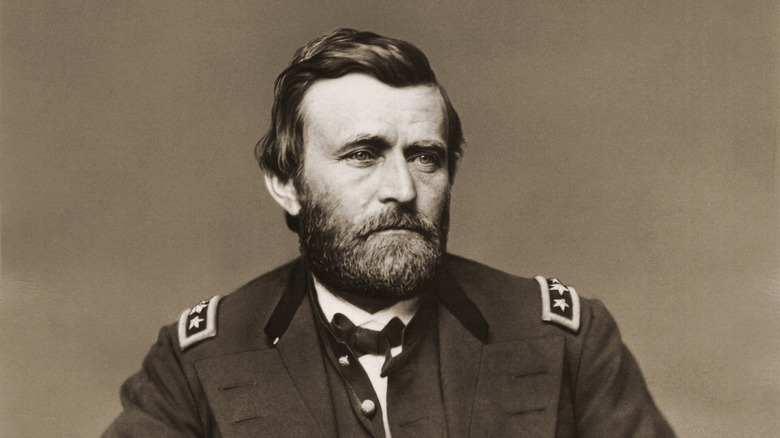
Stock Montage/Getty Images
Ulysses S. Grant's breakfasts changed over time, particularly once he became president. Gary Knepp, Clermont County's honorary historian, told the Clermont Sun that, in his earlier years, Grant reportedly ate a somewhat jarring combination of pickled cucumber and coffee for breakfast. His simple tastes were left over from military life when food was often whatever was on hand.
But once he was in the White House, his meals took on a more traditional shape. He initially hired a military cook, but his wife, Julia, later chose to hire an Italian chef, Valentino Melah. With a new chef at the helm, breakfasts commonly included flannel cakes, buckwheat cakes, fried apples, bacon, steak, and broiled Spanish mackerel.
What remained consistent, though, was coffee — always strong, always black. Grant was a coffee devotee, often drinking it throughout the day. This breakfast reflects the post-Civil War era's idea of hearty, sustaining meals. Grant had a small appetite overall, but when he did eat, he preferred rich, filling foods. The inclusion of steak and mackerel might sound heavy today, but they were energizing proteins for a day that likely started early and ran long.
Theodore Roosevelt: Hard-boiled eggs, rolls, and coffee
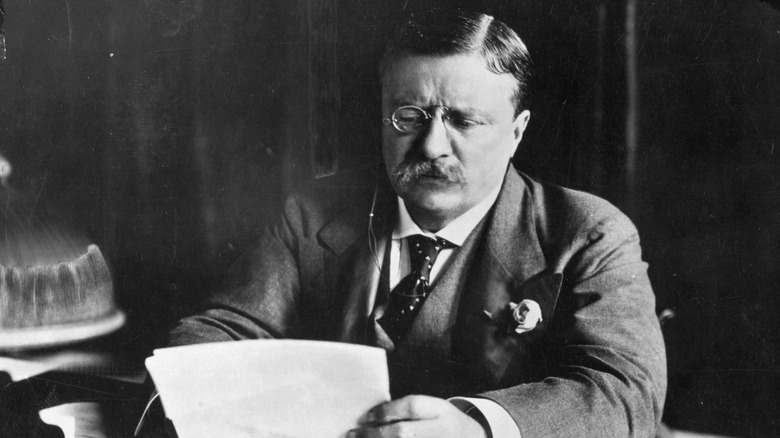
Hulton Archive/Getty Images
Theodore Roosevelt may not have had elaborate breakfasts, but they were substantial. Most mornings began with hard-boiled eggs — never medium or soft — and a type of roll known as a fat rascal. Roosevelt also reportedly enjoyed bacon and liver at the breakfast table, with hominy porridge also said to have made it onto the morning menu.
Fat rascals are rich, scone-like biscuits baked with currants or raisins, which might seem like a strange pairing with eggs, but the combo is said to have been one of Roosevelt's go-to meals. If you want to try them, there are still plenty of recipes in existence today. Alongside his food, Roosevelt always drank coffee. In fact, his son recalled that he drank his coffee from a mug so large it was more like a bathtub (via Smithsonian Magazine). All in all, it seems as though Roosevelt's breakfast choices were about function, not ceremony.
William Howard Taft: Steak and buttered toast
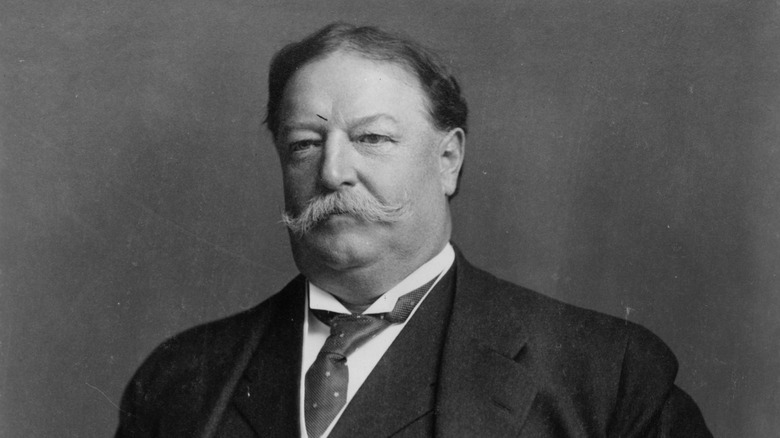
Mpi/Getty Images
While some presidents preferred a simple breakfast, William Howard Taft went all out. He ate a hearty breakfast of steak and buttered toast each morning. According to "Secrets of the White House" by Taft's housekeeper, Elizabeth Jaffray, an average breakfast for Taft specifically consisted of a 12-ounce steak, several pieces of toast and butter, and two oranges, all washed down with plenty of coffee, taken with sugar and cream.
This might sound a bit intense, but around the turn of the 20th century, steak was a fairly normal breakfast food for people of a certain socio-economic status. Steak was still a symbol of wealth and success, and for someone born into a prominent Ohio family, it was an obvious choice. It's really not much more odd than eating bacon and sausage. This kind of breakfast would've suited someone with a big appetite and a long workday ahead, both of which applied to Taft. Outside of breakfast, Taft was partially responsible for the invention of she-crab soup, as it was made in his honor for a dinner he attended at the home of Robert Goodwyn Rhett, former mayor of Charleston, South Carolina.
Woodrow Wilson: Grape juice and raw eggs
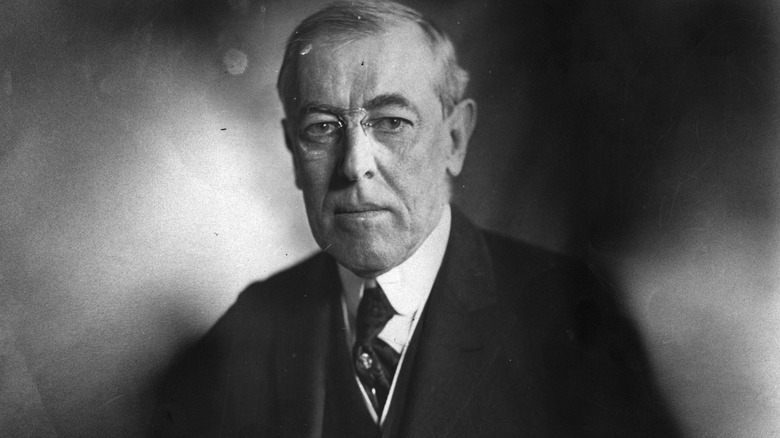
Tony Essex/Getty Images
Woodrow Wilson's breakfast is the most medicinal on this list — and not necessarily appetizing by modern standards. He reportedly drank grape juice mixed with raw eggs. It sounds more than a little bit unappealing, but it was likely prescribed by his doctor.
Wilson is said to have had little interest in food and struggled to keep weight on, something which greatly concerned the White House physician. So, it's likely that this unusual breakfast was a way to get extra calories in without consuming a heavy meal. It may not be something you'd order at a brunch spot today, but for Wilson, it was an efficient, no-nonsense start to the morning.
But that wasn't the only thing served at the presidential breakfast table during Wilson's term in office. Edith Bolling Galt Wilson, his second wife, was a big fan of corn, so cornmeal pancakes were a common addition. This was a particularly salient choice due to the wheat shortages of World War I.
Franklin D. Roosevelt: Donuts
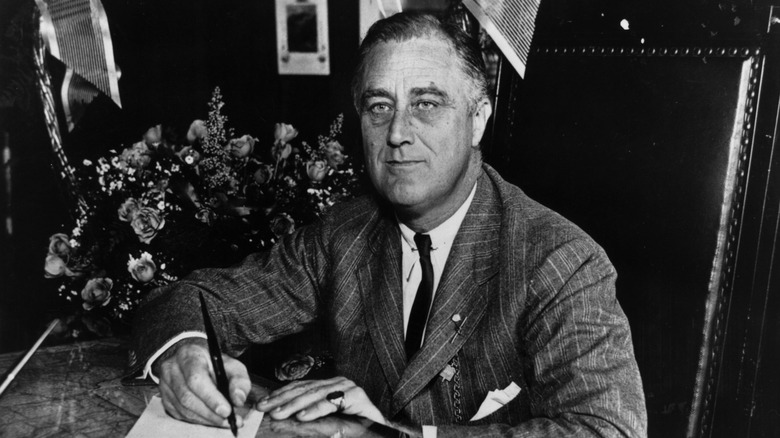
Keystone Features/Getty Images
The White House kitchen had a reputation for serving particularly bad food during FDR's time in office. This partially comes down to the fact that Roosevelt led the nation through the Great Depression. While the American people as a whole were short on food and money, Franklin and Eleanor Roosevelt ate frugally in solidarity. But it's also true that Eleanor Roosevelt reportedly had no interest in food, so it's natural that meals weren't a high priority. During FDR's time in office, Eleanor also hired Henrietta Nesbitt – who had no professional cooking experience and a taste for plain American fare — as housekeeper. All this adds up to a rather lackluster culinary experience.
But when it came to breakfast, FDR had one particular favorite: donuts. In particular, he adored Berliner pfannkuchen, which are hot jam-filled donuts. Nesbitt would whip up huge batches of these to serve for both breakfast and supper. FDR ate these on a tray in his room with coffee, his favorite of which was a French dark roast. Maybe not the most nutritious of breakfasts, but we support it.
Harry S. Truman: Cereal, eggs, bacon, and toast
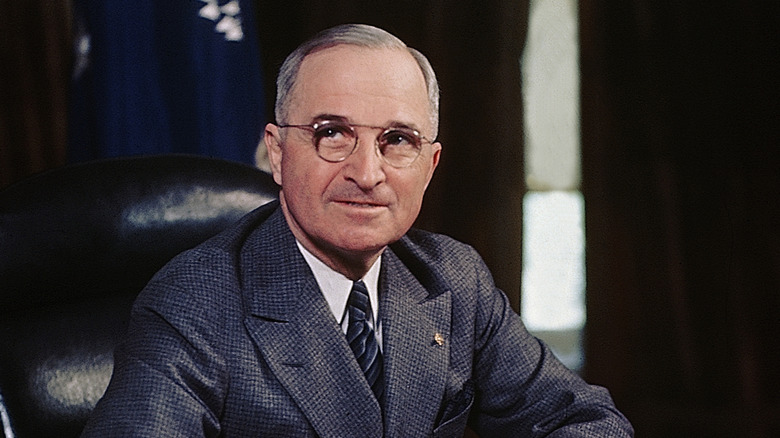
Bettmann/Getty Images
Harry S. Truman believed in moderation and routine, and his breakfast reflected that mindset. Each morning, he sat down to a meal that was satisfying but not extravagant: a bowl of cereal, eggs, bacon, toast, and a big glass of milk. The inclusion of both cereal and eggs speaks to a kind of transitional moment in American breakfasts. By the mid-20th century, boxed cereals had become household staples, advertised as both convenient and healthful. However, more unusually, before he sat down to his full breakfast, he also drank a shot of bourbon and a glass of orange juice before taking a speedy 10-block walk. This was actually a physician-recommended routine — they don't make 'em like they used to.
Truman, who grew up on a Missouri farm, valued consistency and thrift. Even in the White House, he preferred simple, home-style cooking. His breakfast offered a reliable balance of protein, fat, and carbohydrates. Nothing trendy, just what he needed to start the day right. Bourbon shot excluded, perhaps. We know there are some U.S. presidents who barely drank alcohol, but Truman definitely wasn't one of them.
John F. Kennedy: Bacon, eggs, and toast

Bettmann/Getty Images
John F. Kennedy's public image was sleek and refined, but his breakfast was basic, downhome fare that wouldn't be totally out of place on a breakfast table today. Most mornings began with soft-boiled or poached eggs, crispy bacon, and toast with butter and marmalade. It's a breakfast that could easily be found in most American diners. There were some specifics particular to Kennedy. He always liked Pepperidge Farm white bread, according to a note in his wife Jackie Kennedy's handwriting. He also had his bacon broiled rather than fried, because fried food didn't agree with his famously sensitive stomach.
This is the kind of wholesome breakfast that might see someone through a day of running a country. However, JFK did have a less healthy favorite that he would ask for on occasion: waffles. These waffles were made from scratch, as you'd expect at the White House, and served with both maple syrup and melted butter. Despite his cosmopolitan reputation and ties to upper-crust New England, Kennedy's breakfast was unpretentious. It was what millions of Americans ate every day — and maybe that's why it worked for him.
Lyndon B. Johnson: Thick-cut bacon
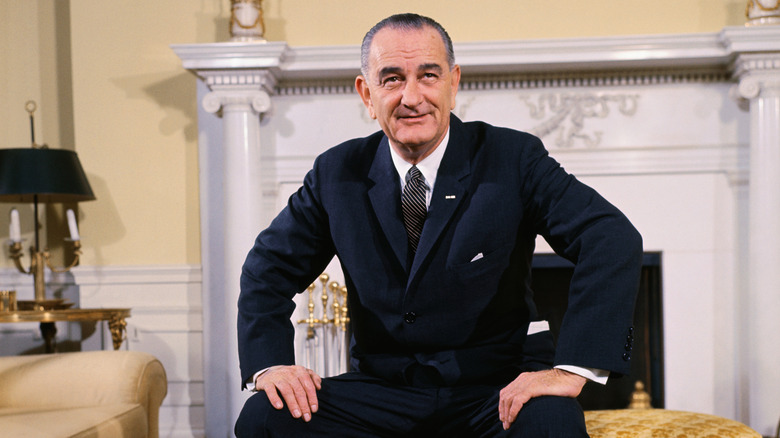
Bettmann/Getty Images
President Lyndon B. Johnson may not have eaten the exact same breakfast every day, but whatever he ate, he usually had it in bed. His work day would typically begin at 6 a.m., but it would start from the bedroom, which is honestly fair enough when you're clocking in so early. His wife, Claudia Alta (also known as Lady Bird), would often join him for breakfast in bed, where thick-cut bacon was a common order.
But it wasn't the only thing on the menu. Johnson's guests were often served a breakfast of spicy deer sausage, toast made from freshly baked homemade loaves, eggs, and peach preserves. If Johnson was following a diet, his breakfast would often consist of half a melon, low-calorie orange juice, and hot tea. Plus, when he needed extra energy, he would also enjoy a slice of lean grilled steak.
Some of Johnson's other favorite foods, which he may or may not have eaten for breakfast, included scrambled eggs, grits, and chipped beef on toast. He also enjoyed cornbread and apple butter. Any one of these foods may have ended up on his breakfast tray now and again.
Richard Nixon: Cottage cheese and ketchup
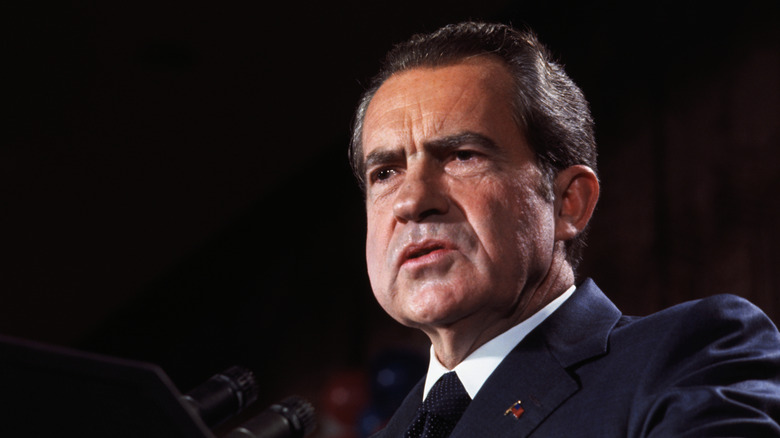
Bettmann/Getty Images
Richard Nixon's breakfast choices have gone down in history — not because they're particularly lavish or delicious, but because they're surprisingly unique. The former president started most days with a cottage cheese and ketchup combo. If you think you might be missing some cultural context from the time period, you aren't. It was just as odd a choice then as it is now.
But it wasn't so much that he loved these two ingredients together. Cottage cheese became popular as a diet food in the mid-20th century, praised for its high protein and low fat content. Nixon was known to be mindful of his weight, and a doctor recommended eating cottage cheese as a healthy meal. The ketchup part is said to be because he didn't like the taste of cottage cheese, and this was meant to improve it. For the same reason, he was also known to eat cottage cheese and pineapple on occasion (including for lunch on the day that he resigned from office). We're not convinced that adding ketchup makes cottage cheese taste better. It seems worse than the sum of its parts. But we're not here to yuck anyone's yum.
Gerald Ford: Orange juice, melon, English muffins, and tea
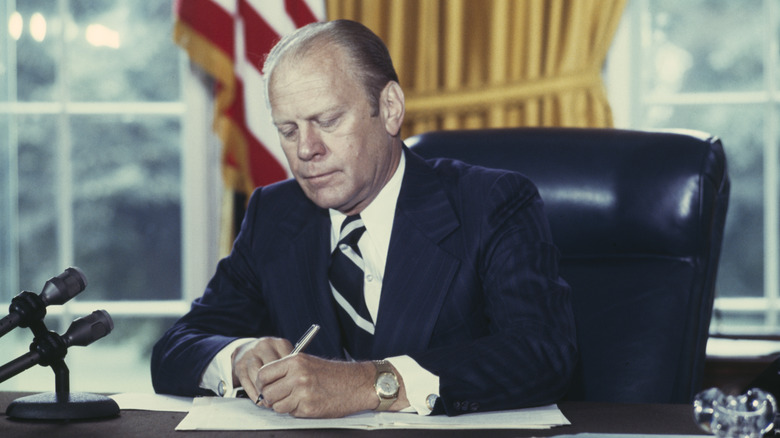
Bettmann/Getty Images
Gerald Ford's breakfast was light, balanced, and health-conscious, especially for the 1970s. It seems fitting for a man who prided himself on staying active well into his presidency. His morning meal usually included English muffins, melon, orange juice, and tea with lemon.
Ford was a college athlete and maintained an interest in fitness throughout his life. That sensibility showed up in his food choices. His breakfast didn't overdo it. He wasn't eating anything fried or slathered in sugar, just a simple, wholesome meal. It might not be the most interesting breakfast to ever have graced the White House, but we can't fault his healthy choices. The presence of tea over coffee also sets him apart from many of his predecessors. It suggests a gentler start to the morning rather than an intense caffeine jolt. Combined with the fruit and toasted muffin, it paints a picture of a calm routine.
Barack Obama: Eggs, potatoes, and toast
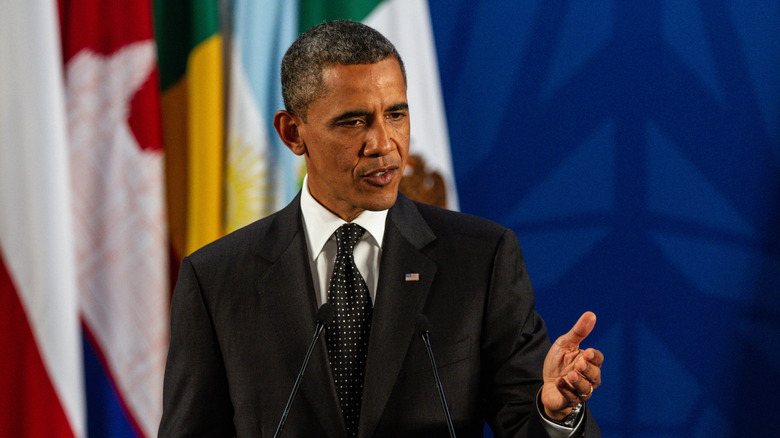
Octavio Hoyos/Shutterstock
On most days in office, Barack Obama ate eggs — sometimes up to six in one serving — with some form of potatoes and wheat toast. Fruit and oatmeal were sometimes also on the menu, with the latter providing a healthier alternative to boxed cereal. Another thing we know about what Barack Obama really eats is that coffee wasn't always his go-to beverage at the White House. Instead, Obama's former personal aide, Reggie Love, told Business Insider that he preferred to drink orange juice, water, or green tea.
Obama came into office during a health-conscious era, and his approach to food mirrored that. His breakfast wasn't full of fancy, indulgent choices. A combination of eggs, potatoes, and toast is the kind of morning meal that most Americans could recognize instantly and would have easily fueled a day full of hard work and big decisions during Obama's eight years in office.



